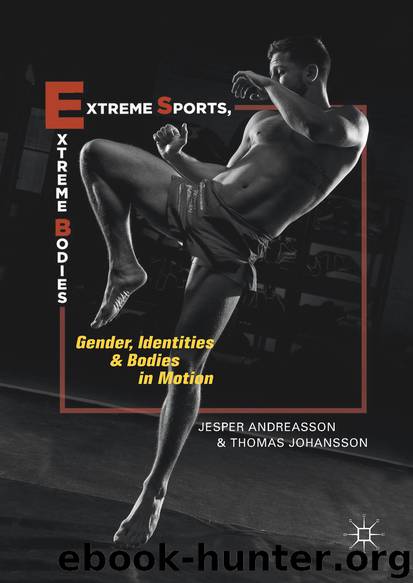Extreme Sports, Extreme Bodies by Jesper Andreasson & Thomas Johansson

Author:Jesper Andreasson & Thomas Johansson
Language: eng
Format: epub
ISBN: 9783319972381
Publisher: Springer International Publishing
Conclusions: Transformational Bodily Processes
Situated at the intersection of the body, the mind and a social system in which boundary-transgressing expressions are considered acceptable and even rather desirable, this chapter has focused on the transformational and transgressive bodily experiences of Ironman triathlon competitors. In the spirit of a carnalising sociology (Crossley 1995), we have focused not only on what athletes do with their bodies, but also on how the work of the body and embodied practices have a transcendent potential that is formative for the sense of self and social order. It is possible to interpret these forms of extreme sports and extreme desires as attempts to escape from a routinised everyday life.
In the process of disciplining the body, the athletes re-conceptualise the sensation of pain and nausea and even disgust, turning these emotionally expressive bodily feelings into part of the experience and bending them towards the pleasure of reaching divinity. These sacred experiences, detached from explicitly religious references, are clearly present in the extreme physical experiences described in the analysed narratives. With reference to Bataille (1993), we can speculate on the social and psychological form of the entire experience of being an Ironman. According to our informants, their disciplined training—pressing the body towards its boundaries and ultimate limits, vomiting, defecating and exploring pain and bodily fragmentation, slowly approaching the moment when it is possible to test the body and compete in one of the world’s most physically and psychologically demanding sports—makes it all worthwhile. By overcoming all this resistance, desire is made even more meaningful; it assures us of its authenticity, providing the force that comes from the certainty of its dominion and divine status. The stubborn defiance of impossibility, also described in detail by Bataille, is closely connected to the feeling of emptiness and death. Thus, there is both a physical and a psychological danger involved in reaching towards the sky and its limits. Somehow, there is a certain poetic justice in entering a symbolic game with death, in order to transcend the body, reach divinity and feel immersed in the cosmos (Le Breton 2000).
We would like to position this chapter in a long tradition of philosophical and sociological explorations of the transgressing and transcending body. In this tradition, the body is interpreted and understood as a site for change and utopian possibilities. An exploration thus conducted tells us something about contemporary individuals’ exploration of the existential and corporeal dimensions of modernity. Reading Ironman as a lifestyle enterprise and a marker of ongoing social character formation, we can speculate as to how similar phenomena—such as extreme bodybuilding or Mixed Martial Arts—might reveal how individuals defy the boundaries of the possible, striving towards a new corporeality defined by transcendence and unlimited possibilities.
In the next chapter, we will zoom in on the athletes’ intimate sphere—their family relations, gender identities and performativity. We will situate their bodily experiences and challenges in relation to family practices and gender equality ideals.
Download
This site does not store any files on its server. We only index and link to content provided by other sites. Please contact the content providers to delete copyright contents if any and email us, we'll remove relevant links or contents immediately.
Unstoppable by Maria Sharapova(3119)
The Inner Game of Tennis by W. Timothy Gallwey(2990)
Urban Outlaw by Magnus Walker(2950)
Crazy Is My Superpower by A.J. Mendez Brooks(2861)
The Social Psychology of Inequality by Unknown(2311)
The Fight by Norman Mailer(2159)
Unstoppable: My Life So Far by Maria Sharapova(2128)
Going Long by Editors of Runner's World(1922)
Accepted by Pat Patterson(1917)
Motorcycle Man by Kristen Ashley(1862)
The Sports Gene: Inside the Science of Extraordinary Athletic Performance by David Epstein(1823)
The Happy Runner by David Roche(1823)
Backpacker the Complete Guide to Backpacking by Backpacker Magazine(1815)
Sea Survival Handbook by Keith Colwell(1796)
Futebol by Alex Bellos(1786)
Mind Fuck by Manna Francis(1745)
Peak: Secrets from the New Science of Expertise by Anders Ericsson & Robert Pool(1663)
Endure by Alex Hutchinson(1605)
The Call of Everest by Conrad Anker(1551)
